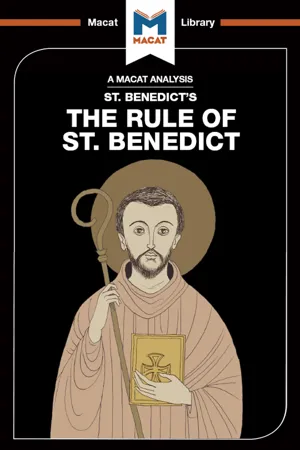
- 90 pages
- English
- ePUB (mobile friendly)
- Available on iOS & Android
An Analysis of St. Benedict's The Rule of St. Benedict
About this book
The Rule of St Benedict, written around 1500 years ago by the Italian monk St Benedict of Nursia, is a slim handbook for monastic life – a subject many modern readers would regard as relatively niche. It is, however, also a model of the organized and clearly expressed thought produced by good reasoning skills – a mainstay of critical thinking.
Reasoning is all about making a good case for something, through logical arguments, neatly and systematically organised. In Benedict's case, his main concern was to lay out a set of rules and practices that would allow monasteries to run as well-organised communities. Communal living presented huge challenges, and yet it was also, Benedict believed, the best way for monks to sustain themselves, their religion, and the learning and teaching that went with it. His Rule laid out concise but detailed chapters on the best way to achieve this, including provisions for all areas of personal and communal discipline, right down to how tasks might be allotted to individual monks.
Providing a complete roadmap for successfully running a community, the concise brilliance of The Rule has even been suggested by some business professors as useful model for running small businesses today.
Frequently asked questions
- Essential is ideal for learners and professionals who enjoy exploring a wide range of subjects. Access the Essential Library with 800,000+ trusted titles and best-sellers across business, personal growth, and the humanities. Includes unlimited reading time and Standard Read Aloud voice.
- Complete: Perfect for advanced learners and researchers needing full, unrestricted access. Unlock 1.4M+ books across hundreds of subjects, including academic and specialized titles. The Complete Plan also includes advanced features like Premium Read Aloud and Research Assistant.
Please note we cannot support devices running on iOS 13 and Android 7 or earlier. Learn more about using the app.
Information
Table of contents
- Cover
- Title Page
- Copyright Page
- Table of Contents
- WAYS IN TO THE TEXT
- SECTION 1: INFLUENCES
- SECTION 2: IDEAS
- SECTION 3: IMPACT
- Glossary of Terms
- People Mentioned in the Text
- Works Cited